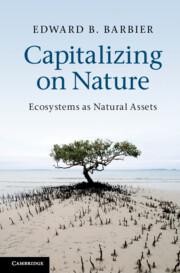Book contents
- Frontmatter
- Contents
- Figures
- Tables
- Boxes
- Acknowledgments
- Introduction
- 1 Ecological scarcity as an economic problem
- 2 Ecosystem services and ecological landscapes
- 3 The basic natural asset model
- 4 Spatial variation in ecosystems
- 5 The open economy
- 6 Ecological collapse
- 7 The way ahead
- 8 Policies in the Age of Ecological Scarcity
- Index
- References
6 - Ecological collapse
Published online by Cambridge University Press: 05 June 2012
- Frontmatter
- Contents
- Figures
- Tables
- Boxes
- Acknowledgments
- Introduction
- 1 Ecological scarcity as an economic problem
- 2 Ecosystem services and ecological landscapes
- 3 The basic natural asset model
- 4 Spatial variation in ecosystems
- 5 The open economy
- 6 Ecological collapse
- 7 The way ahead
- 8 Policies in the Age of Ecological Scarcity
- Index
- References
Summary
An important observation here is that, although an order of magnitude loss in habitat only leads to a 50% reduction in species number, this represents a change in community structure equivalent to an average of one trophic level decline in the average trophic position of the species persisting in the community … We would thus expect to see an initial sequential reduction in economic goods and services as natural systems are degraded, followed by a more rapid sequential collapse of goods and services.
(Dobson et al. 2006, p. 1921)Introduction
As we have seen throughout this book, the tendency of the risk of ecological collapse to rise with landscape conversion can play a pivotal role in determining ecosystem conservation decisions. A number of ecological studies confirm that irreversible landscape conversion increases the threat of ecosystem collapse (Busing and White 1993; Dobson et al. 2006; Lotze et al. 2006; Peterson et al. 1998; Turner et al. 1993). That is, the ability of an ecosystem to survive may be linked to how much of its landscape size or scale remains. Biological productivity, ecosystem functioning, biodiversity, and ecological resilience appear to be affected by the spatial scale of an ecosystem (Dobson et al. 2006; Halpern et al. 2005; Peterson et al. 1998; Wellnitz and Poff 2001). As the ecological landscape declines or is degraded, essential processes and components are disturbed, and the system becomes vulnerable to collapse.
Ecologists are beginning to measure how such linkages unfold. For example, Dobson et al. (2006) find that the proportion of surviving species, species diversity, and the trophic level of ecosystems tend to fall exponentially as the fraction of remaining ecosystem habitat declines. The loss of habitat causes first a thinning of species throughout the food web of an ecosystem, followed by rapid loss of the top trophic levels in the web. As food webs and trophic levels largely define ecosystems, this process of trophic implosion can easily trigger ecosystem collapse. The consequence, as the above quote by the authors indicates, is that the declining proportion of habitat area is linked directly to rapid declines in ecosystem goods and services and a higher risk of overall collapse.
- Type
- Chapter
- Information
- Capitalizing on NatureEcosystems as Natural Assets, pp. 199 - 231Publisher: Cambridge University PressPrint publication year: 2011



